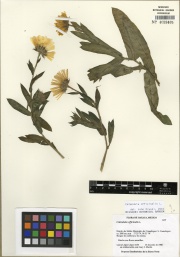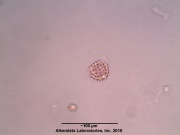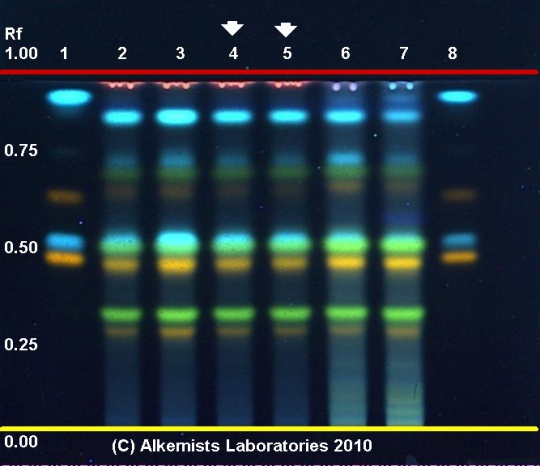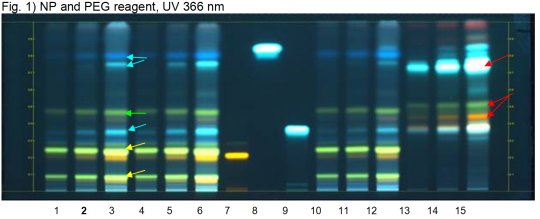Calendula officinalis (flower)
Contents |
Nomenclature
Calendula officinalis L. Asteraceae
Standardized common name (English): calendula
Botanical Voucher Specimen
|
Macroscopic Characteristics
Microscopic Characteristics
|
|
High Performance Thin Layer Chromatographic Identification
|
Marigold (flower) (Calendula officinalis) Lane Assignments Lanes, from left to right (Track, Volume, Sample):
Reference materials used here have been authenticated by macroscopic, microscopic &/or TLC studies according to the reference source cited below held at Alkemists Laboratories, Costa Mesa, CA. Stationary Phase Silica gel 60, F254, 10 x 10 cm HPTLC plates Mobile Phase ethyl acetate: HCOOH: Acetic acid: H2O [10/1.1/1.1/2.4] Sample Preparation Method 0.3 g + 3 ml CH3OH sonicate/heat @ 50° C ~ 1/2 hr. Detection Method Natural Product Reagent + PEG -> UV 365 nm Reference see Plant Drug Analysis, Wagner, H., 1996
|
|
Calendula (flower) (Calendula officinalis) Lane Assignments Lanes, from left to right (Track, Volume, Sample):
Reference Sample(s) Reference: Dissolve 2.5 mg of rutin in 5 mL of methanol. Dissolve 3 mg of caffeic acid in 5 mL of methanol. Optional: dissolve 1.5 mg of chlorogenic acid in 5 mL of methanol. Stationary Phase Stationary phase, i.e. Silica gel 60, F254 Mobile Phase Ethyl acetate, formic acid, water 80:10:10 (v/v/v) Sample Preparation Method Sample: Mix 0.5 g of powdered sample with 5 mL of methanol and sonicate for 10 minutes, then centrifuge or filter the solutions and use the supernatants / filtrates as test solutions. Derivatization reagent: 1.) NP reagent Preparation: 1 g of natural products reagent in 200 mL of ethyl acetate 2.) PEG reagent Preparation: 10 g of polyethylene glycol 400 in 200 mL of dichloromethane Use: Heat plate for 3 min at 100°C, dip (time 0, speed 5) in NP reagent while still hot, dry and dip (time 0, speed 5) in PEG reagent Detection Method Saturated chamber; Developing distance 70 mm from lower edge; Relative humidity 33% Other Notes Images presented in this entry are examples and are not intended to be used as basis for setting specifications for quality control purposes. System suitability test: Rutin: a yellow fluorescent zone at Rf ~ 0.21; Caffeic acid: a white-blue fluorescent zone at Rf ~ 0.85 Identification: Compare result with reference images. The fingerprint of the test solution is similar to that of the corresponding botanical reference sample. Additional weak zones may be present. The chromatogram of the test solution shows a yellow zone corresponding to the reference material rutin. Right above and below rutin there are a green zone each at Rf ~ 0.23 and 0.09 (yellow arrows). A green fluorescent zone in the middle of the chromatogram is detected at Rf ~ 0.46 (green arrow). Three blue-white zones are present at Rf ~ 0.35, 0.75 and 0.80, the two last zones are right below caffeic acid (blue arrows). Test for adulteration: No orange and green zones are seen at Rf ~ 0.45 and 0.51 and no blue-white zone is seen at Rf ~ 0.72 (red arrows, Arnica flower).
|
Supplementary Information
Cite error: <ref> tags exist, but no <references/> tag was found




